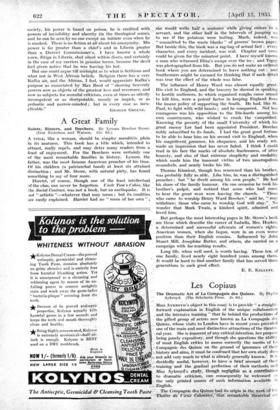Les Copiaus •
The Dramatic Art of La Compagnie des Quinze. By 'Phyllis Aykroyd. (The Scholartis Press. 2s.
Miss AYKROYD'S object-in this essay is to provide " a straight- forward explanation in English of the unique collaboiation , and the intensive training " that lie behind the produdiOns of the gifted group of ..actors now known as La Compagnie des Quinze, whose visits to London have in recent years provided one of the main and most distinctive attractions of the theatri- Cal year. She is innocent of any critical intention, her purpose being purely expository, and though she questions the ability of most English critics to assess correctly the merits 'of La Compagnie des Quinze on the ground of ignorance of -their history and aims, it must be-confessed that her own study does not add very much to what is'already generally known. It is decidedly useful,' however, to have-_a brief account oft their training and. the gradual perfection of their methodS;.:and Miss Aykroyd's study, though negligible as a contribution to dramatic criticism, can. consequently be welcomed as the only printed source of such information available in English. • The Compagnic des Quinze ltad its origin in the, work •of Thedlte du -'17thir Catonibicr,- `that remarkable Theatrical ■-■ -
ganization which Jacques Copeau started in Paris in 1918, and which by now must have had its imitators in a dozen different countries. M. Copeau's intention was to break with current theatrical modes and realize a conception of drama, not entirely new perhaps but at that time unexpressed, 'Which was based on " a perfect combination of acting, staging, colour, music, silence "—no one element being more important than the other, but each having to be perfectly realized to produce the intended effect. He aimed at extreme simplicity in set- ting. There was a permanent stage, and generally no scenery ; when there was, only small decorative pieces were used which did not obscure the permanent stage setting. M. Copeau's approach to classical material involved also a complete sever- ance from current accepted ideas. In his productions of Moliere's comedies, for instance, he returned to the presen- tational' methods which Moliere himself had used in the days when he toured the country and gave performances of impro- vised farces on a trestle-platform in a tent or in the open air. There was no attempt at the kind of illusion possible with a picture-frame stage, but the method had the result of focussing the attention of the audience more surely upon the actor on the stage " whose every gesture (became) as it were, enlarged, whose every movement (formed) part of a linear design." Naturally these methods of production received little but
• abuse and neglect from a press and a public which profesied an unwavering allegiance to the traditions of the Comedic Francaise, and although M. Copeau's work had the support of an enthusiastic minority, the Vieux Coknnbier during its eleven years of activity was seldom unthreatened by financial pressure. Finally, the strain proved too great for M. Copeau, and in 1924 he was compelled to retire from the Paris theatre.
His retirement led to another theatrical venture quite unique in our time. He withdrew to the village of Pernand- Vergelesses in Burgundy, taking with him a group of pupils, and there, " in the most unsophisticated of surroundings," started on a fresh course of prolonged training in preparation for the company's reappearance. They took part in the country festivals and vintage-celebrations of the province, and moved about giving " diversions " which were immensely popular with the country people. Over two years were spent in this manner before M. Copeau permitted his company to appear in a town, and then they were restricted to the provinces. By this time Les Copiaus had become a highly-organized theatrical unit. As at the Vieux Colombier, the plays were produced without scenery, and rhythm and symmetry were aimed at rather than realism. Versatility in every actor was insisted upon, there were no star performers, and every production was regarded as an intimate collaboration between author, actors, and producer.
One of these productions happened to be seen by M. Andre Obey, a dramatist of great originality and some repute, who until then had found no medium capable of executing his ideas satisfactorily. Feeling entirely in sympathy with the com- pany's methods, he suggested to. M. Copeau that they should collaborate, and it was from this point, with the transformation of " Les Cop. iaus " into " La Compagnie des Quinze," that the results of M. Copeau's teaching began to win the reward of international recognition. M. Copeau still wished to remain in retirement himself, but it was with his approval that M. Obey brought the company back to Paris in 1931. Their first productions in Paris were Nod and Le Viol de Luerke, and they were followed by the more inipoitant La Bataille de la Maiiie and Loire, and the less satisfactory Don Juan, each of which, with the exception of Loire, has been seen in London. Of each of these plays Miss Aykroyd gives an adequate description and analysis—though she should beware of claiming originality for M. Obey (and Mr. Bernard Shaw) in their employment of a device—the use of modern colloquialisms in the dialogue of historical plays—which was extensively employed three cen- turies ago by Shakespeare. La Compagnie des Quinze, who have for the time being parted company with M. Obey, and have lately embarked on a second period of rustication, intend to give a series of performances in London this year, and those who in the past have found difficulties in appreciating their work could not dO belfer-to remove the barrier formed by an unfamiliar dramatic convention than read Miss Aykroyd's painstaking little book.
DEREK VERSCUOYLE.:



















































 Previous page
Previous page